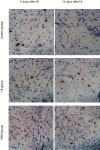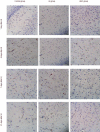Hyperbaric oxygen treatment promotes neural stem cell proliferation in the subventricular zone of neonatal rats with hypoxic-ischemic brain damage
- PMID: 25206416
- PMCID: PMC4107609
- DOI: 10.3969/j.issn.1673-5374.2013.13.007
Hyperbaric oxygen treatment promotes neural stem cell proliferation in the subventricular zone of neonatal rats with hypoxic-ischemic brain damage
Abstract
Hyperbaric oxygen therapy for the treatment of neonatal hypoxic-ischemic brain damage has been used clinically for many years, but its effectiveness remains controversial. In addition, the mechanism of this potential neuroprotective effect remains unclear. This study aimed to investigate the influence of hyperbaric oxygen on the proliferation of neural stem cells in the subventricular zone of neonatal Sprague-Dawley rats (7 days old) subjected to hypoxic-ischemic brain damage. Six hours after modeling, rats were treated with hyperbaric oxygen once daily for 7 days. Immunohistochemistry revealed that the number of 5-bromo-2'-deoxyuridine positive and nestin positive cells in the subventricular zone of neonatal rats increased at day 3 after hypoxic-ischemic brain damage and peaked at day 5. After hyperbaric oxygen treatment, the number of 5-bromo-2'-deoxyuridine positive and nestin positive cells began to increase at day 1, and was significantly higher than that in normal rats and model rats until day 21. Hematoxylin-eosin staining showed that hyperbaric oxygen treatment could attenuate pathological changes to brain tissue in neonatal rats, and reduce the number of degenerating and necrotic nerve cells. Our experimental findings indicate that hyperbaric oxygen treatment enhances the proliferation of neural stem cells in the subventricular zone of neonatal rats with hypoxic-ischemic brain damage, and has therapeutic potential for promoting neurological recovery following brain injury.
Keywords: brain injury; grants-supported paper; hyperbaric oxygen; hypoxic-ischemic brain damage; neonatal hypoxic-ischemic encephalopathy; neonatal rats; nestin; neural regeneration; neural stem cells; neurons; neuroregeneration; proliferation; subventricular zone.
Conflict of interest statement
Figures




References
-
- Shi XD, Tao SH, Li QP, et al. Incidence investigation and risk factor analysis on hypoxic-ischemic encephalopathy in newborn babies of Guangdong province. Zhonghua Shenjing Yixue Zazhi. 2008;7(1):42–45. 50.
-
- Kelen D, Robertson NJ. Experimental treatments for hypoxic ischaemic encephalopathy. Early Hum Dev. 2010;86(6):369–377. - PubMed
-
- Fan X, van Bel F. Pharmacological neuroprotection after perinatal asphyxia. J Matern Fetal Neonatal Med. 2010;23(Suppl 3):17–19. - PubMed
-
- Gulczyńska E, Gadzinowski J. Therapeutic hypothermia for neonatal hypoxic-ischemic encephalopathy. Ginekol Pol. 2012;83(3):214–218. - PubMed
LinkOut - more resources
Full Text Sources
